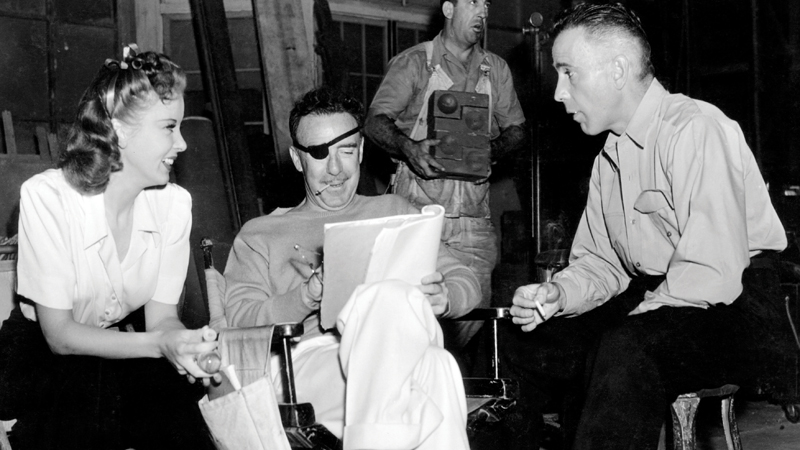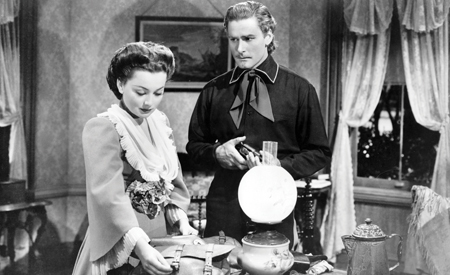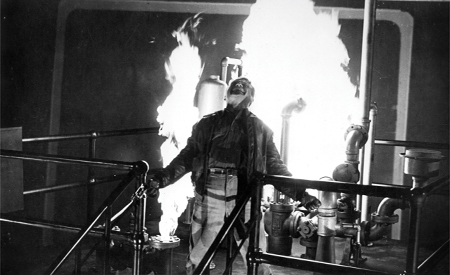BY RICHARD SCHICKEL
Raoul Walsh didn’t always follow the action he was filming with stark concentration. He would listen to the dialogue his actors were reciting while wandering, with apparent aimlessness, around the set. He sometimes referred to the words as “titles,” and when they ran their course he would call “cut,” and according to the likes of Robert Mitchum would inquire how it had gone.
“All right, I guess,” the actor would reply. “Knocked over the lamp halfway through.”
“Pick it up?” Walsh would ask. “Look natural?”
“Yeah, I guess so,” would come the response.
“OK, print it.”
Mitchum was, of course, exaggerating a bit, but the truth was that that’s the way Walsh made movies--casually, confidently, and above all, prolifically. He co-directed his first film in 1914 and made his last one, 140 or so later, in 1964 (for the record, it was a pretty good cavalry Western called A Distant Trumpet, starring Troy Donahue).
He doubtless could have made some more films, but he was 77 by that time, still lean and fit, but maybe enough was enough. Although in those years, when I knew him, he didn’t seem to think so; he seemed ready to go if the call came. But mostly he hung out on a nice little ranch in the further reaches of the Simi Valley, where he ran a few horses and plucked oranges from the trees in his front yard and yarned with guys like me. I made a film on him and inordinately enjoyed the pleasure of his company.

Raoul Walsh (center) on the set of High Sierra (1941) with Ida Lupino and Humphrey Bogart. (Photo: Warner Bros. Pictures)
It’s possible that Raoul was the most fecund director in the history of the medium. It may be that some B picture craftsman ground out more footage than he did. The records are a little dimÑand really of no matter. Suffice it to say that he made a helluva lot of movies and that a large number of them were works of considerable qualityÑgenre pieces (crime, war, comedy), but lively, entertaining, and expert, and often enough touched by a quite surprising doomy grandeur that, to this day, rewards our close attentionÑand still doesn’t get enough of it in my estimation.
The range of his work is astonishing. There’s Gen. George Armstrong Custer’s farewell to his wife on the eve of the Battle of Little Bighorn (“Walking through life with you, ma’am, has been a very gracious thing”) in They Died with Their Boots On (1941); the tender love storyÑno other word for itÑof best-friend boxers John L. Sullivan and James J. Corbett in Gentleman Jim (1942); the savage splendor of the “crash-out” in High Sierra (1941); gangster James Cagney’s race through the snowy streets to his doom in The Roaring Twenties (1939). As he dies in the snow on the church steps the camera pulls slowly back, and Gladys George utters an unimprovable epitaph: A cop asks who Cagney was and she softly replies, “He used to be a big shot.” There is also the sweetness and delicately managed sentiment of The Strawberry Blonde (1941), and the violent, comic hysteria of what is surely Walsh’s masterpiece, White Heat (1949), with Cagney’s last line delivered on top of an oil refinery while being mowed down by coppers: “Made it, Ma! Top of the world!”
Which leaves out, also in White Heat, Cagney sitting in his mother’s lap while enduring a monstrous headache. It is a powerful and almost tragic scene. It is also a repeat of a sequence in Cagney’s screen debut, Sinner's Holiday (1930). Raoul knew enough to steal from the best when he had to.
He put it out that he was a soft touch for Jack Warner’s sob stories about how the studio chief couldn’t get as much work out of his other directors as he wanted, and there was perhaps an element of truth in that legend. The man did love to work. He made his fair share of undistinguished films, but how could it be otherwise, given his sheer volume? But there was never anything routine about his filmmaking. He made, as Andrew Sarris said, a lot of “maddeningly routine” films in terms of plots and characters, but he was also, as David Thomson wrote, “a natural,” a man seemingly incapable of a bad shot or a sloppy edit. There is ease to his work--a rightness--that never fails to astonish.

They Died with Their Boots On (1941)
Walsh began his career as an actor riding treadmills in stage plays, notably played John Wilkes Booth in D.W. Griffith’s The Birth of a Nation (1915), appeared in his own Sadie Thompson (1928) opposite Gloria Swanson, and lost an eye shooting In Old Arizona (1929), after which he stopped acting. He had, however, already contributed as a director two very fine and highly contrasting films to the silent film repertory: The Thief of Bagdad (1924), Douglas Fairbanks’ lithe and witty fairy tale, and What Price Glory? (1926), a tough, masterful and tragedy-touched war film. The range of subject matter of these two films alone seems to me to guarantee the range of Raoul’s talents. He was saying, implicitly, that he could direct anything if he set his mind to it.
He was never ignored--he was too productive for that. And abroad, particularly in France, he was, as the years wore on, very highly regarded. He was, of course, a man’s man as a director, undoubtedly Cagney’s best, and possibly Gable’s, too (they made three films together--The Tall Men, Band of Angels, and The King and Four Queens--from 1955-57). But he could be excellent with certain types of women as well--Virginia Mayo, Jane Russell, Mae West--ladies who didn’t “primp.” Or “strike poses” as he liked to put it. If they wanted to be in on the joke--or telling it--that was OK with him.
Yet, an odd--and totally unearned--air of mild disappointment hangs over this career, which I want to disabuse us of. He never won an Oscar, was never, in fact, nominated for one. Many of his peers--Alfred Hitchcock, Howard Hawks, King Vidor--also failed to win Academy Awards, but eventually were rewarded with honorary ones, which they accepted with good grace, amidst standing ovations. Not so for Raoul. An antique history of movies, written before he ascended to the pantheon, dimly described Hawks as “a good all-arounder,” and I suppose it would go for Walsh as well. I sometimes wondered if it rankled him, but I rather doubted it.
He was too busy for that--and too good-natured. That was true of many of the first generation directors. Having invented their profession, they rode with it in a rather uncomplicated fashion. It was fun and profitable and in its early days its prizes were not as important as they have become in more recent times. The fact is that winners were, on the whole, staid and respectable, and occasionally decent enough, but by today’s standards mainly sort of dead in the water. We have since redefined what constitutes a good movie and the “good all-arounders” are the auteurs who represent for us the mainline of American film history, and continue to hold our delighted attention.
Walsh, and others like him, hardly operated below the radar. Their movies were the ones we wanted to see. I remember noticing his name at the Friday night shows I religiously attended when I was a kid and noticing, too, that they were (by my standards) well-made, lively and sometimes more than that (Uncertain Glory [1944] springs to mind).

White Heat (1949)
That they often starred Errol Flynn, who was, I’m not abashed to say, my favorite actor in those days--what a wonderfully dashing and sometime soulful gallant he was at the top of his form--a fringe benefit beyond compare.
It is significant that Raoul’s best work was done in genre pieces, in Westerns and such, that owed nothing to the other dramatic forms that the movies took. They were all pieces that really did not come into being until film itself was invented. Which means we did not fully appreciate their inventiveness and exuberance at the time. We liked them without quite knowing why, and they were basic to the movie-going experience of the 1930s and ’40s. It is only in retrospect that we see how very good the best of them were.
I think these films were dependent on their lack of self-consciousness, the way they tossed off comedy and tragedy, and the range of emotions in between those two states, as they galloped along. Raoul often talked about finishing a picture on a Saturday night and hearing a script thump down on his front porch and starting to prepare for it some time in the next day or two. He did not usually think he was making art, though he had a fairly acute sense of the difference between the good and the bad. He was, on the whole, a man doing a job.
It is, of course, a way of making pictures that is now totally lost in an era where movies take months and even years to get up and running--and are not necessarily the better for the time and money so invested. It is wrong to grow nostalgic about the old ways of doing. They made plenty of bad pictures back then, too.
On the other hand, a career like Raoul’s is no small thing. To be so prolific is, I would say, a good thing. If nothing else, it prevents you from brooding about your flops--it keeps you up and doing and in the game. Most important, you are bound, if you keep working steadily, to make some pretty good pictures. The odds are definitely in your favor.
And that says nothing of the sheer joyousness of the life Raoul Walsh led, the fun he had. The kicker for his career is obvious: Cagney’s mad laughter as he cries out, “Made it, Ma! Top of the world!”